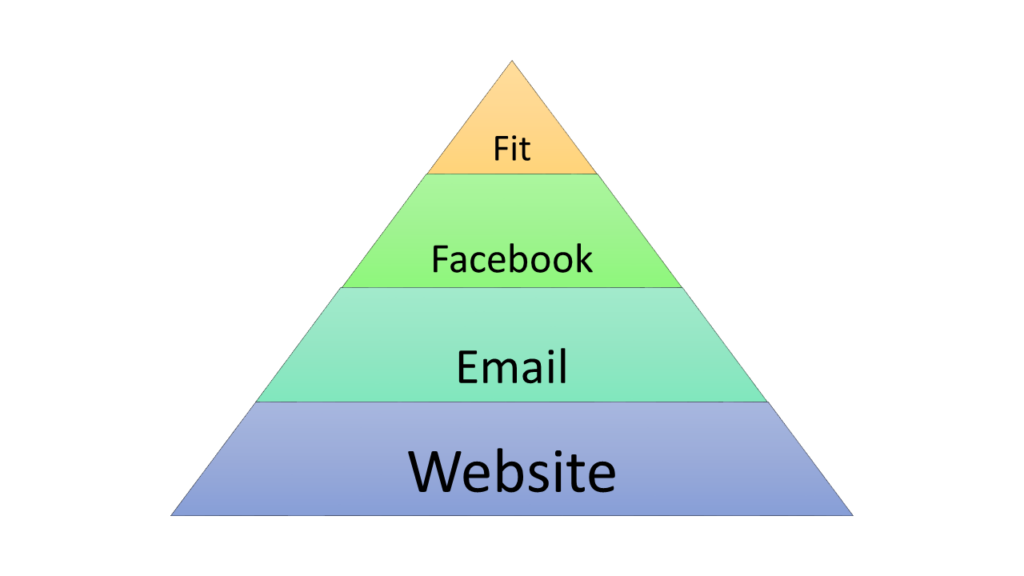Grow Your Church Communications a Piece at a Time
Before a church can have an effective social media strategy, it needs to understand the importance of older communications channels in a social media world. A strong email and website ministry will give you a firm foundation with which to effectively leverage social media.

Website: Your Church’s Front Door
Your website is your church’s curb appeal, your front sign, your new front door. Virtually everyone will check out your church online before they commit to showing up in person. If they can’t imagine participating in the life of your church based on what they see on your website, you can’t expect them to ever show up in person.
Notice how the “church newsletter” didn’t make the pyramid. Your website is a far superior hub of information. It can updated and distributed in real time, and it can be interactive as well. It’s also a great place to integrate your other social media channels.
There are four popular ways that social media is integrated on church websites:
- Social Media Buttons. These are icons somewhere on the header or footer of your website that point to your social media sites.
- Social Media Comments. Integrating social media into your comment system will extend the conversation into outside arenas such as Twitter.
- Social Media Sharing. Sharing buttons on your posts or events allow people to easily share them on their own social media channels.
- Embedded Newsfeeds. Embedding your social media feeds on your website (i.e. having a constantly updated at-a-glance look at your posts, Tweets etc.) is an advanced feature. I put this one last because they will often slow down the page load times of the pages they are on.
Email: Getting Church to Their Inbox
Email is still vastly superior to Facebook when it comes to having a captive audience. Your followers on Facebook will only get your posts in their newsfeeds about 8.5% of the time, but they’ll get 100% of your emails in their inbox. But wait…will they open them? Ideally, at least 30% of your mailing list participants will open any given email. However, believe it or not emails don’t need to be opened for them to have an effect. Smart phone users can get email subject lines as notifications on their phones in real time. This means you should consider sending emails with one subject, an informative headline, and a timely release. Obviously, this is quite a different approach than most churches take for running their email campaigns.
You should have a prominent email signup form on your website and expect guests to join the lists. Because the list is open to all, it is important to avoid jargon and insider language.
Finally, if you are using a mass email service like MailChimp or Constant Contact you can put social media sharing buttons and links right in the email.
Facebook: Still Dominating the Social Environment
Facebook has always been a natural fit for churches. They have the right combination of people using the service regularly, the ability to post events, groups one can join, and a welcome area (i.e. the newsfeed). Even smaller churches should consider having (and using) a Facebook page.
Many churches think the only thing they should post is news and updates about the church, but there are so many other great possibilities a church can explore and try. In fact, only posting promotional content can actually hurt your chances of showing up in someone’s newsfeed. So, think about posting such items as:
- Sermon-related questions for feedback
- Quotes from the previous sermon or the upcoming one
- High-fives for great accomplishments by members of the church
- News about the local businesses or community events in your neighborhood. (Be sure to tag those businesses or organizations.)
- Stories from recent events
- Reviews of books people should read
- Links to thought-provoking articles
Fit: Have You Found Yours?
Fit means using the social media tools that fit best with your church community, culture, and ministry. While “Fit” is on the top of the pyramid and is the smallest component, it is where some of the most exciting and influential uses of social media happen and is arguably the future of digital ministry. Here are some examples of Fit:
- If you record videos of your sermons, be sure to put them up on YouTube or Vimeo.
- If you have a strong photo ministry, consider Pinterest and Instagram.
- If your congregation has their Bibles up on their smart phones during worship, have them Tweet questions and comments in real time on Twitter.
- In general, try to use the social media channels that your congregation is already using most.
Now, Talk About It…
How is your pyramid doing? What parts do you need to attend to in coming weeks? Consider talking about this article as a church staff to determine what some next steps could be. Though we don’t want to take the metaphor too far (after all, the pyramids were built with a lot of slave labor!) it certainly does take a team to build a pyramid, one block at time.
